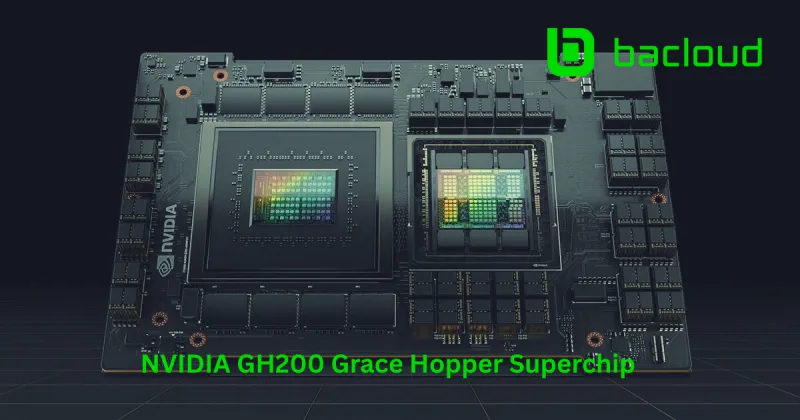- Tuesday, August 26, 2025

NVIDIA’s GH200 Grace Hopper Superchip fuses an Arm-based Grace CPU with a Hopper-class GPU on one module, linked by a custom, ultra-fast interconnect. For deep learning teams, the headline is simple: more usable memory, far higher CPU↔GPU bandwidth, and substantial per-chip inference gains versus previous generations—especially when models are memory-hungry.
What the Superchip Actually Is
-
CPU + GPU on one “superchip” connected by NVLink-C2C at 900 GB/s—about 7× faster than PCIe Gen5—so tensors, KV-caches, and embeddings move with far less overhead.
-
High-bandwidth memory on the GPU (HBM3/HBM3e) and LPDDR5X on Grace act like a shared, fast pool for large models and data pipelines.
-
GH200 NVL2 = two Grace Hopper superchips fully linked: up to 288 GB HBM, ~10 TB/s memory bandwidth, and ~1.2 TB of “fast memory” per node—3.5× the GPU memory and 3× the bandwidth of an H100 server. Ideal for large embeddings and long-context language models.
Deep-Learning Performance: Real Numbers You Can Bank On
1) Inference vs H100
-
In MLPerf Inference v3.1, GH200 delivered up to 17% higher per-accelerator throughput than H100 SXM across the official workloads, thanks to bigger/faster memory and the 900 GB/s CPU↔GPU link.
2) Training/Graph workloads vs H100 PCIe
-
For Graph Neural Networks (GNNs), NVIDIA shows up to 8× faster training on GH200 versus H100 PCIe, attributing the lift to the combined fast memory and NVLink-C2C. (Think fraud-detection, molecular graphs, social graphs.)
3) Why memory & interconnect matter for LLMs/RAG
-
RAG and vector DBs: embedding generation and vector search achieve significant speedups by avoiding CPU↔GPU copies. NVIDIA cites a ~30× faster embedding generation compared to CPU-only baselines when Grace handles preprocessing and ships tensors to Hopper over NVLink-C2C.
Bottom line: GH200 isn’t just “more FLOPS.” It’s higher tokens/sec per watt at larger batch sizes because memory bottlenecks and CPU ↔ GPU transfer costs drop significantly.
How It Compares to an Older Generation GPU (A100)
The most widely cited, apples-to-apples public benchmarks are MLPerf:
-
H100 vs A100 (training): In MLPerf Training v3.0, H100 delivered up to 3.1× more performance per accelerator than A100 across workloads.
-
GH200 vs H100 (inference): As noted above, GH200 adds up to +17% per-accelerator inference over H100 SXM in MLPerf v3.1.
Putting this in practical terms for deep-learning stacks:
-
If you’re moving from A100 to H100, expect ~2–3× per-GPU gains on mainstream DL training/inference (workload-dependent).
-
If you’re serving large models and step up to GH200, you also capture memory-driven speedups (bigger batches, fewer stalls) and +17% per-chip MLPerf inference uplift versus H100—plus major wins from the NVL2 node’s memory scale if your bottleneck is embeddings/KV cache.
In short: from A100 → H100 → GH200, you gain raw compute and a progressively better memory/interconnect story. For today’s LLMs and GNNs, that memory story often dominates.
Quick Spec & Capability Snapshot
| Feature | GH200 (Superchip) | GH200 NVL2 (2× GH200) | H100 SXM (older vs GH200) |
|---|---|---|---|
| CPU↔GPU link | NVLink-C2C @ 900 GB/s (≈7× PCIe Gen5) | NVLink-C2C within each superchip; NVLink between the two | CPU↔GPU over PCIe (platform-dependent) |
| GPU memory | HBM3/HBM3e on-package | Up to 288 GB HBM per node | Up to 80 GB HBM2e (SXM) |
| “Fast memory” pool (GPU HBM + Grace LPDDR) | Hundreds of GB; used for big embeddings/KV cache | ~1.2 TB per node | GPU HBM only |
| Notable DL results | Up to +17% over H100 (MLPerf Inference v3.1) | 3.5× GPU memory & 3× bandwidth vs H100 node | — |
| GNN training | — | — | Baseline for up to 8× GH200 speedup (PCIe H100) |
Which One Should You Choose?
-
You’re on A100 today, training LLMs/CV
Moving to H100 provides the most significant raw compute jump (often 2–3 times per GPU). If your models are not memory-bound, H100 may be the most cost-efficient next step. -
You’re serving large models or wrestling with embeddings/KV caches
GH200 is built for this: higher per-chip inference compared to H100, significantly larger effective memory pools, and dramatically lower CPU-to-GPU overheads. Expect higher batch sizes and better latency at steady state. -
You need a single node that behaves like a “big GPU”
GH200 NVL2 nodes deliver 288 GB HBM and ~1.2 TB fast memory with ~10 TB/s bandwidth—ideal for recommender systems, long-context LLMs, GNNs, and RAG at scale.
Practical Tips (so you don’t leave performance on the table)
-
Utilize memory headroom by increasing batch sizes and sequence lengths; pin embeddings/KV cache in HBM where possible. GH200’s larger fast memory pool is the point.
-
Profile CPU↔GPU transfers: on H100/SXM, PCIe copies can eat >20% of inference time for some recsys workloads; GH200’s NVLink-C2C slashes that to low single digits.
-
Use current stacks: TensorRT-LLM / CUDA-X, along with mixed precision (FP8/FP16), were used in the MLPerf runs—mirror those configurations to approach the published numbers.
Conclusion
-
If you’re coming from A100, the H100 jump delivers the largest pure compute uplift for deep learning—validated in MLPerf Training and Inference.
-
If your workloads are memory-bound (RAG, recommenders, long-context LLMs, GNNs), GH200 goes further: +17% MLPerf inference over H100, up to 8× GNN-training speedups vs H100 PCIe in NVIDIA’s data, and NVL2 nodes with 3.5× the GPU memory of an H100 server.
One-line takeaway: for modern deep learning, GH200 turns “memory is the bottleneck” into a design advantage—and that often translates into faster models, fewer nodes, and better energy economics.
